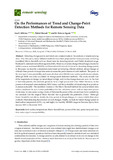Mostrar el registro sencillo del ítem
On the performances of trend and change-point detection methods for remote sensing data
| dc.creator | Militino, Ana F. | es_ES |
| dc.creator | Moradi, Mohammad Mehdi | es_ES |
| dc.creator | Ugarte Martínez, María Dolores | es_ES |
| dc.date.accessioned | 2020-07-06T08:41:21Z | |
| dc.date.available | 2020-07-06T08:41:21Z | |
| dc.date.issued | 2020 | |
| dc.identifier.issn | 2072-4292 | |
| dc.identifier.uri | https://hdl.handle.net/2454/37336 | |
| dc.description.abstract | Detecting change-points and trends are common tasks in the analysis of remote sensing data. Over the years, many different methods have been proposed for those purposes, including (modified) Mann-Kendall and Cox-Stuart tests for detecting trends; and Pettitt, Buishand range, Buishand U, standard normal homogeneity (Snh), Meanvar, structure change (Strucchange), breaks for additive season and trend (BFAST), and hierarchical divisive (E. divisive) for detecting change-points. In this paper, we describe a simulation study based on including different artificial, abrupt changes at different time-periods of image time series to assess the performances of such methods. The power of the test, type I error probability, and mean absolute error (MAE) were used as performance criteria, although MAE was only calculated for change-point detection methods. The study reveals that if the magnitude of change (or trend slope) is high, and/or the change does not occur in the first or last time-periods, the methods generally have a high power and a low MAE. However, in the presence of temporal autocorrelation, MAE raises, and the probability of introducing false positives increases noticeably. The modified versions of the Mann-Kendall method for autocorrelated data reduce/moderate its type I error probability, but this reduction comes with an important power diminution. In conclusion, taking a trade-off between the power of the test and type I error probability, we conclude that the original Mann-Kendall test is generally the preferable choice. Although Mann-Kendall is not able to identify the time-period of abrupt changes, it is more reliable than other methods when detecting the existence of such changes. Finally, we look for trend/change-points in land surface temperature (LST), day and night, via monthly MODIS images in Navarre, Spain, from January 2001 to December 2018. | en |
| dc.description.sponsorship | This work has been supported by Project MTM2017-82553-R (AEI/ FEDER, UE). It has also received funding from la Caixa Foundation (ID1000010434), Caja Navarra Foundation, and UNED Pamplona, under agreement LCF/PR/PR15/51100007. | en |
| dc.format.extent | 25 p. | |
| dc.format.mimetype | application/pdf | en |
| dc.language.iso | eng | en |
| dc.publisher | MDPI | en |
| dc.relation.ispartof | Remote Sensing, 2020, 12(6), 1008 | en |
| dc.rights | © 2020 by the authors. Licensee MDPI, Basel, Switzerland. This article is an open access article distributed under the terms and conditions of the Creative Commons Attribution (CC BY) license. | en |
| dc.rights.uri | http://creativecommons.org/licenses/by/4.0/ | |
| dc.subject | Land surface temperature | en |
| dc.subject | Mann-Kendall test | en |
| dc.subject | Power of the test | en |
| dc.subject | Spatio-temporal data | en |
| dc.subject | Time series | en |
| dc.subject | Type I error probability | en |
| dc.title | On the performances of trend and change-point detection methods for remote sensing data | en |
| dc.type | info:eu-repo/semantics/article | en |
| dc.type | Artículo / Artikulua | es |
| dc.contributor.department | Estadística, Informática y Matemáticas | es_ES |
| dc.contributor.department | Estatistika, Informatika eta Matematika | eu |
| dc.contributor.department | Institute for Advanced Materials and Mathematics - INAMAT2 | es_ES |
| dc.rights.accessRights | info:eu-repo/semantics/openAccess | en |
| dc.rights.accessRights | Acceso abierto / Sarbide irekia | es |
| dc.identifier.doi | 10.3390/rs12061008 | |
| dc.relation.projectID | info:eu-repo/grantAgreement/AEI/Plan Estatal de Investigación Científica y Técnica y de Innovación 2013-2016/MTM2017-82553-R/ES/ | en |
| dc.relation.publisherversion | https://doi.org/10.3390/rs12061008 | |
| dc.type.version | info:eu-repo/semantics/publishedVersion | en |
| dc.type.version | Versión publicada / Argitaratu den bertsioa | es |



